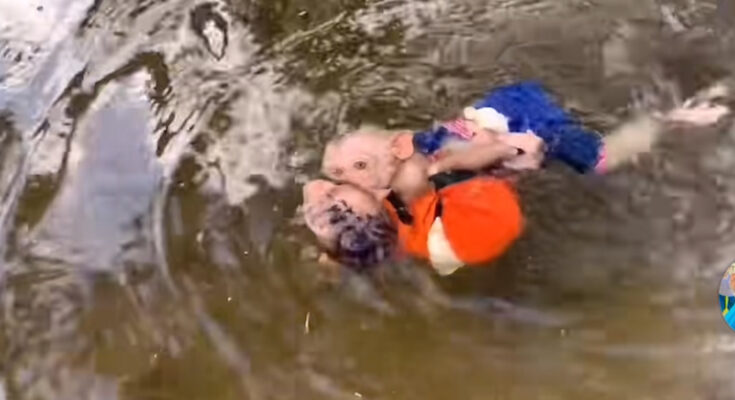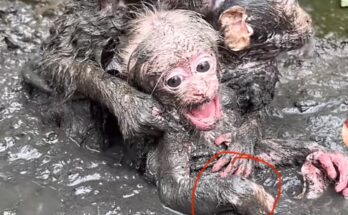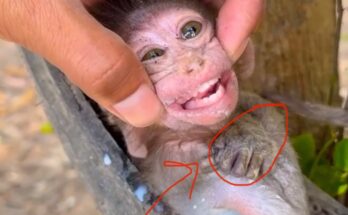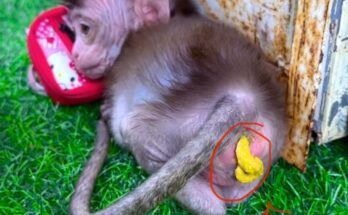If you ever find yourself in the unfortunate situation of witnessing a baby monkey in distress, particularly in water, acting swiftly and knowledgeably is essential to ensure its survival. Whether you come across a baby monkey in a flooded area, a river, or an accidental fall into a body of water, your response can make all the difference between life and death for this helpless creature. Here’s a comprehensive guide on how to save a baby monkey from drowning and provide it with the care it needs to recover and thrive.
1. Assess the Situation
Before jumping into action, take a moment to assess the situation. Is the baby monkey already drowning, or is it in danger of doing so? If it’s submerged, you need to act immediately. However, if it’s struggling to stay afloat but still conscious, a more controlled approach may be necessary to avoid startling or panicking the animal further.
2. Rescue the Baby Monkey
Time is critical when saving an animal from drowning. If the baby monkey is already underwater, carefully pull it out using an object (such as a branch, stick, or net) to avoid direct contact, especially if the monkey appears stressed or injured. If you can safely grab the monkey without causing harm, do so gently, and immediately move it to a dry and secure location.
-
Avoid direct force: Baby monkeys are fragile, so handle them with care.
-
Do not use aggressive methods: Avoid sudden movements that could further frighten or injure the monkey.
3. Assess the Monkey’s Health
Once you have removed the monkey from the water, check for signs of life. The baby may be lethargic, gasping, or unconscious due to oxygen deprivation. If the monkey is not breathing, performing CPR may be necessary. To do so:
-
Clear the airway: Gently tilt the baby monkey’s head back to open the airway.
-
Provide rescue breaths: Gently blow air into the monkey’s nose, covering both nostrils with your mouth.
-
Chest compressions: If you don’t see the chest rising after a few breaths, perform gentle chest compressions to encourage the heart to start beating again.
If the monkey starts breathing on its own, keep it warm and comfortable as you move to the next phase of recovery.
4. Warm the Baby Monkey
After a traumatic event like drowning, hypothermia is a serious risk. Baby monkeys have small bodies that lose heat quickly. To prevent this, you need to keep the monkey warm and comfortable:
-
Wrap it in a towel or blanket: A soft, dry cloth will provide warmth and comfort.
-
Provide warmth gently: If available, place the baby near a heat source, like a warm water bottle or heating pad on a low setting (always avoid direct heat that could burn the skin).
5. Hydrate and Nourish the Baby Monkey
Once the monkey is stable, it’s crucial to offer it hydration and nutrition to help it regain strength:
-
Hydration: If the baby monkey is not yet eating solid food, provide an electrolyte solution or diluted infant formula. Use a syringe or dropper to offer fluids slowly.
-
Feeding: Depending on its age and species, a baby monkey may require a milk formula designed for primates. Do not feed it cow’s milk, as it may cause digestive issues.
6. Monitor for Signs of Injury or Infection
After the rescue and initial care, the baby monkey may need a veterinary evaluation, particularly if it has sustained any injuries or ingested contaminated water. Look for signs such as:
-
Difficulty breathing
-
Limpness or lack of coordination
-
Visible wounds or swelling
If the monkey is exhibiting any of these symptoms, it is critical to contact a veterinarian who specializes in wildlife or exotic animals.
7. Provide Emotional Support
Monkeys are highly social creatures and can experience stress or trauma after being separated from their group or family. Offering the baby monkey a comforting and quiet environment is important for emotional recovery. If possible, keep the monkey in a safe and secluded space where it won’t be overwhelmed by loud noises or activity.
8. Release or Long-Term Care
Once the baby monkey has recovered sufficiently, it’s important to consider its future. If the monkey is old enough to be released and there is a safe habitat nearby, contact a wildlife rehabilitation center to assess the situation and possibly reintroduce the monkey to the wild. If the monkey is too young or cannot be released safely, a qualified wildlife center may provide long-term care to ensure its well-being.
Conclusion
Saving a baby monkey from drowning is a challenging and delicate task that requires quick thinking, gentleness, and knowledge of animal care. By acting swiftly to rescue, stabilize, and care for the monkey, you can increase its chances of survival and recovery. Always consult wildlife experts or veterinarians for professional assistance, especially if the baby monkey shows signs of injury or illness. By providing the right care, you not only save a life but also help restore a young creature’s chance at a healthy future.



